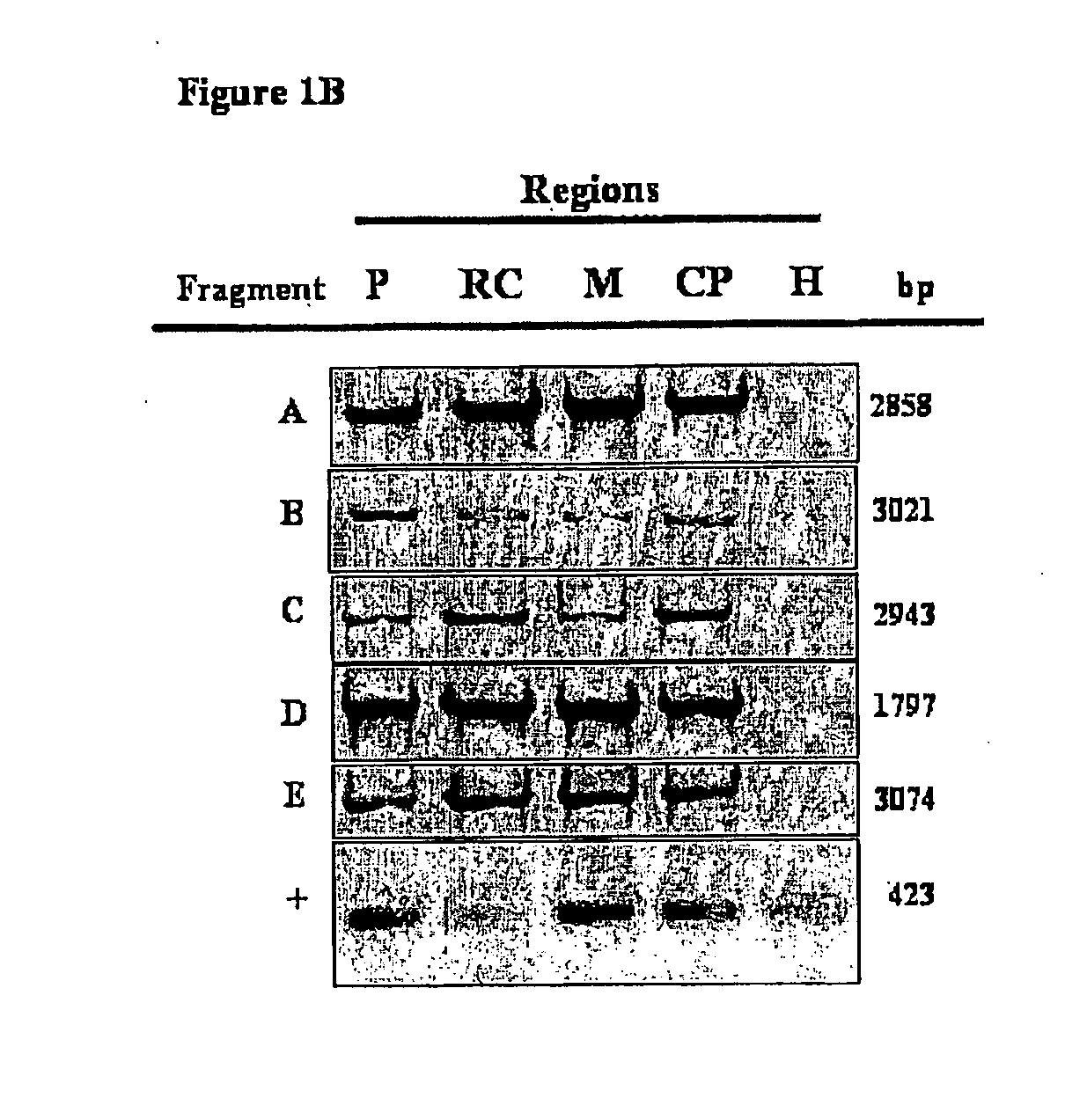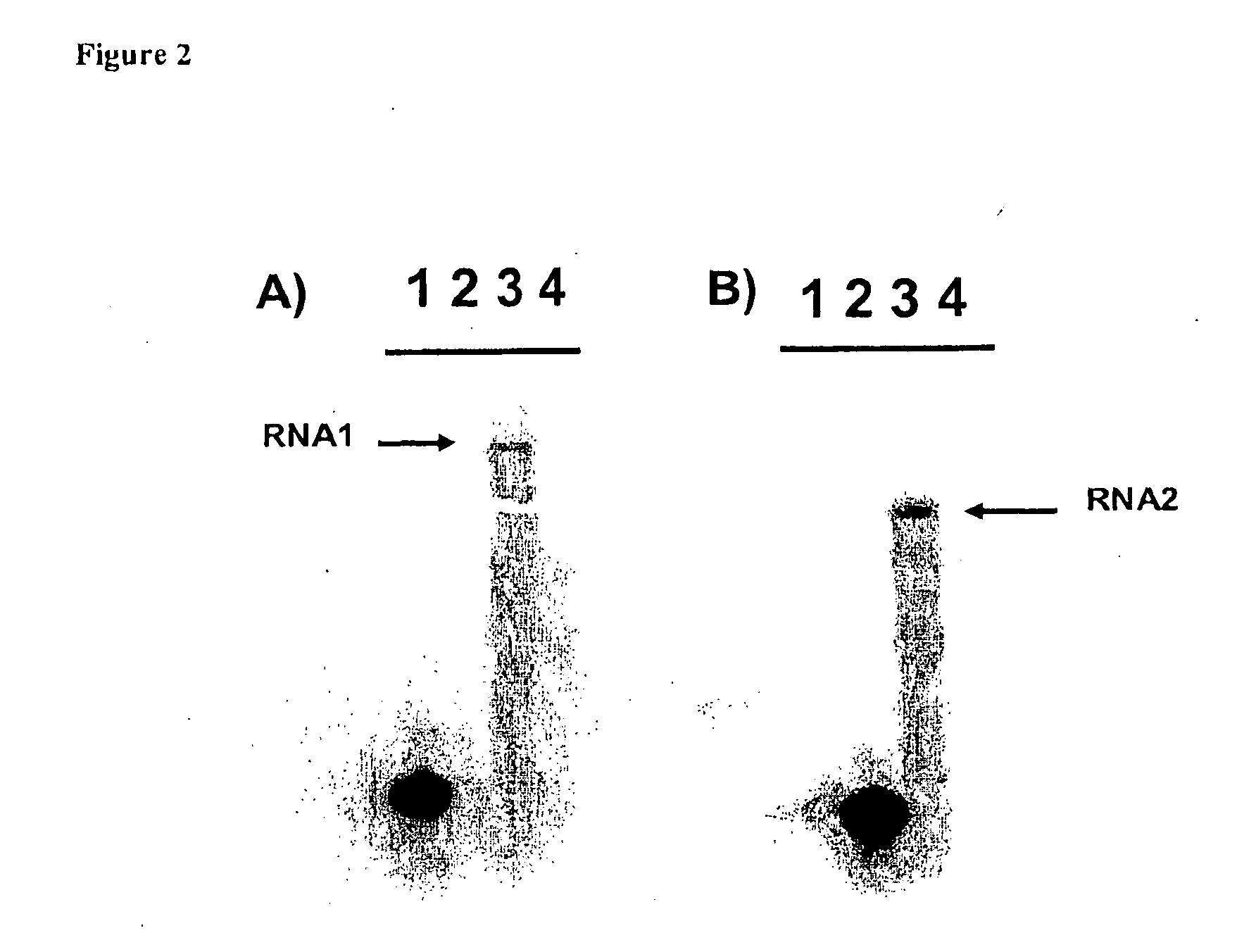Isolated nucleic acid molecules from the genome of citrus leprosis virus and uses thereof
a technology of citrus leprosis and nucleic acid molecules, applied in the field of nucleic acid molecules and proteins of phytopathogenic viruses, can solve the problems of serious tree decline, over 100 million dollars in annual expenditures devoted to exterminating this mite, and loss of millions of sweet orange trees grafted on to sour orange rootstocks
- Summary
- Abstract
- Description
- Claims
- Application Information
AI Technical Summary
Problems solved by technology
Method used
Image
Examples
example 1
[0049]This example describes the identification and cloning of nucleic acid molecules from CiLV by RT-PCR. Total RNA was extracted from symptomatic and asymptomatic leaves. First strand cDNA was synthesized using 4 μg of total RNA as template, 250 ηg of oligonucleotides, and was denatured at 65° C. for 5 minutes. The solution was then incubated on ice while adding 1 μl of 10 mM dNTP mix and 3 μl of First Strand buffer (250 mM Tris-HCl, pH 8.3, 375 mM KCl, 15 mM MgCl2) to the tube. The mixture was incubated at room temperature for 2 min, 1 μl (200 U) of reverse transcriptase was added and the solution was further incubated at room temperature for 10 min. followed by 60 min. at 42° C. For PCR, 2 μl of the first strand cDNA was used as template, 0.125 mM each dNTP, 2 mM MgCl2, 1×reaction buffer (20 Mm Tris-HCl, pH 8.4, 50 mM KCl), 1 U of Taq polymerase and 0.4 μM of each of primer pair: REP13 5′ ACAGACTACGTGAAATATACC 3′ (SEQ ID NO. 13) and REP14 5′ CGTGAAACTCCGAATCCATT 3′ (SEQ ID NO 14...
example 2
[0050]In this experiment Northern blotting was carried out on RNA samples extracted from symptomatic and asymptomatic leaves. DNA fragments from the movement protein and replicase partial genes CiLV were used as probes. FIG. 2 shows the band pattern in symptomatic plants and positive controls with both probes, while no bands were identified in the asymptomatic material with both probes.
[0051]Total RNA from bark tissue of symptomatic and asymptomatic plants was extracted using the Trizol Reagent (Invitrogen) according to the manufacturer's protocol. Ten micrograms of total RNA from each sample were separated by denaturing electrophoresis on a 1% agarose gel containing 1×MOPS and 0.6M formaldehyde, according to Sambrook and Russell (2001), supra. The gel was subsequently transferred to a Hybond-N+ nylon membrane by capillary transfer in 10×SSC (1×SSC is 0.15M NaCl; 0.015M sodium citrate) for 16 hours. The membrane was baked at 80° C. for 2 hours, prehybridized in hybridization buffer ...
example 3
[0052]This example describes the identification and cloning of nucleic acid molecules from CiLV-C by RT-PCR from viruliferous mites. First strand cDNA was synthesized using 4 μg of total RNA as template, 250 ηg of oligonucleotides and denatured at 65° C. for 5 minutes. The solution was then incubated on ice while adding 1 μl of 10 mM dNTP mix and 3 μl of First Strand buffer (250 mM Tris-HCl, pH 8.3, 375 mM KCl, 15 mM MgCl2) to the tube. The mixture was incubated at room temperature for 2 min, 1 μl (200 U) of reverse transcriptase was added and the solution was further incubated at room temperature for 10 min. followed by 60 min. at 42° C. For PCR, 2 μl of the first strand cDNA was used as template, 0.125 mM each dNTP, 2 mM MgCl2, 1×reaction buffer (20 mM Tris-HCl, pH 8.4, 50 mM KCl), 1 U of Taq polymerase and 0.4 μM primers: MP21 5′ GGTTGCTTTACGTTCGAGTGTGA 3′ (SEQ ID NO 19) and MP13 5′ CGTTGTGGAGACCCAGAGCA 3′ (SEQ ID NO 20). The reaction was heated for 5 min. at 94° C. and subjected...
PUM
| Property | Measurement | Unit |
|---|---|---|
| size | aaaaa | aaaaa |
| pH | aaaaa | aaaaa |
| pH | aaaaa | aaaaa |
Abstract
Description
Claims
Application Information
 Login to View More
Login to View More - R&D
- Intellectual Property
- Life Sciences
- Materials
- Tech Scout
- Unparalleled Data Quality
- Higher Quality Content
- 60% Fewer Hallucinations
Browse by: Latest US Patents, China's latest patents, Technical Efficacy Thesaurus, Application Domain, Technology Topic, Popular Technical Reports.
© 2025 PatSnap. All rights reserved.Legal|Privacy policy|Modern Slavery Act Transparency Statement|Sitemap|About US| Contact US: help@patsnap.com



